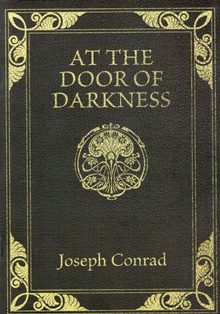
Published in this chapbook format back in January of 2021, Joseph Conrad’s ‘At The Door Of Darkness’ was released by Sangrail Press to provide a missing passage that’d been removed from the original publication of Conrad’s classic novella ‘Heart Of Darkness’ (1899).
The chapbook is an exquisitely presented publication, limited to just one hundred individually numbered copies, and not only provides the missing text, but also a host of additional material.
On his way up the vast African river towards his destination of the company’s Inner Station, Charlie Marlow arrives at the Seat of the Government where he would stop off briefly and partake in a meal at a nearby hotel, before pressing on towards his eventual destination. The food there is far from pleasant, even for Marlow, who is a man who’s lived largely off his own poor cooking.
After leaving the hotel, Marlow makes his way through the rundown locale, observing the dilapidation of the place, the soldier’s huts mere wooden shanties expressing little in the way of authority.
Form here, he takes aboard a small river steamer for the remaining thirty-miles, where he speaks with the vessel’s captain, a Swede, who knowing Marlow to be a fellow seaman, invites him onto the steamer’s bridge.
Here conversion between these two worldly men turns to the inhabitants of the land, and the darkness contained therewithin. For only the other day the Swede cam across a man who had hung himself out on the road. The sun, or maybe the country, had evidently taken its toll on the poor individual.
This break in the journey upriver is only short lived, but for Marlow, as he leaves these last vestiges of civilization, he can’t help but ponder, was this place the comedy of light at the door of darkness…
With my 1994 Penguin Classics print of ‘Heart Of Darkness’, this missing passage slots into the first new paragraph on page 21 (which you might find helpful if attempting to read the novella with this missing section slotted correctly into place).
The entirety of the deleted scene is short and (for this reviewer at least), does not seem to add too much to the story. Undoubtedly Conrad removed the passage from the original text because it slowed down the delivery and pacing of the overall story.
However, what this section does do, when read slotted into the correct place text of the novella, is provide a moment’s pause, a brief, almost fleeting breath of a pause for thought, to ponder that here in this place of urban civilization, it might be the point where Marlow last sees some degree of civilised humanity.
However, dilapidated, however unfavourable to Marlow or his palette, this place might well be that final moment of comical light before the door is opened into absolute darkness.
Additional Material:
This Comedy Of Light At The Door Of Darkness – 3 Pages
The chapbook opens up with a short introduction by Adam Newell, providing some understanding and context behind the text within the chapbook. Here we understand not only where the missing passage slots in, but also Newell’s thoughts on the passage, its relevance, and why Conrad probably chose to remove it. It’s a solid introduction providing the reader with the background needed to appreciate the context of this missing passage.
Facsimiles Of The Original Manuscript – 6 Pages
Next, we have literal scans of the relevant pages for this missing passage from Conrad’s original handwritten manuscript. To be honest, Conrad’s handwriting is quite hard to decipher, made worse still by numerous crossings out and passages underlined.
From The Text As Printed – 1 Page
Here we have an excerpt of the relevant section of the text published text, which is helpful for you to easily contrast and compare the two. It also helps with locating the section where the missing passage slots in.
From ‘Heart Of Darkness The Manuscript Revisions’ – John Raskin – 1 Page
Here we have a short segment taken from John Raskin’s academic paper on the book’s revisions and his view on why Conrad removed this particular section. It’s a short study on the text but does provide a good analysis and view on the piece.
From A Journal Of A Tour In The Congo Free State – Marcus R.P. Dorman – 3 Pages
Finally, we have a one-page write up by a European visitor to the place of Boma, after he passed through the area a few years after Conrad had. Within this section we also have two pages of photographs of the area, showing what it looked like.
The chapbook runs for a total of 20 pages.

© DLS Reviews

